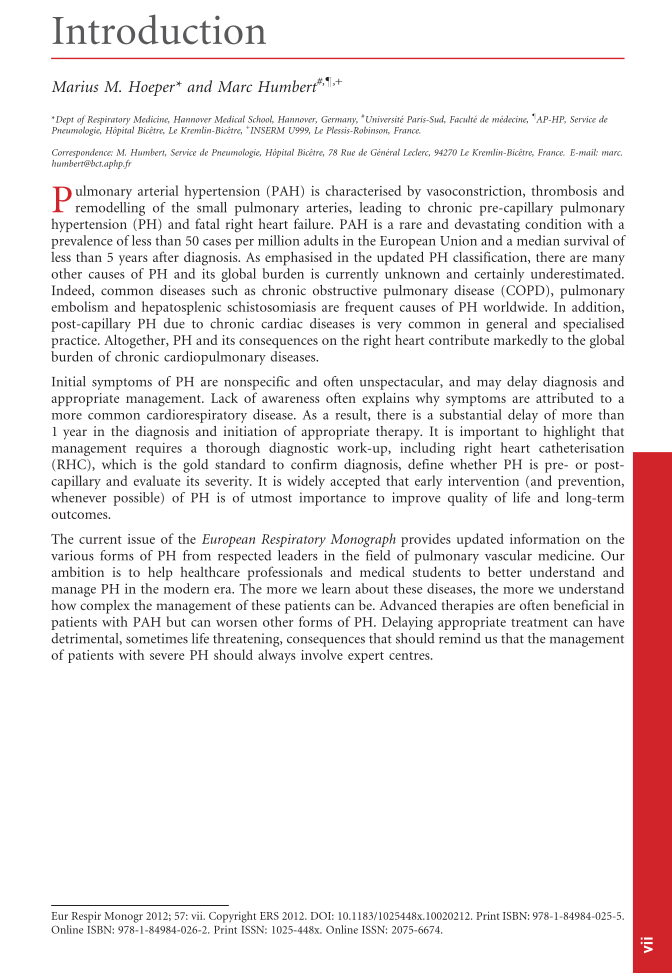Introduction Marius M. Hoeper* and Marc Humbert#,",+ *Dept of Respiratory Medicine, Hannover Medical School, Hannover, Germany, # Universite ´ Paris-Sud, Faculte ´ de medecine, ´ " AP-HP, Service de Pneumologie, Hopital ˆ Bicetre, ˆ Le Kremlin-Bicetre, ˆ + INSERM U999, Le Plessis-Robinson, France. Correspondence: M. Humbert, Service de Pneumologie, Hopital ˆ Bicetre, ˆ 78 Rue de General ´ ´ Leclerc, 94270 Le Kremlin-Bicetre, ˆ France. E-mail: marc. humbert@bct.aphp.fr Pulmonary arterial hypertension (PAH) is characterised by vasoconstriction, thrombosis and remodelling of the small pulmonary arteries, leading to chronic pre-capillary pulmonary hypertension (PH) and fatal right heart failure. PAH is a rare and devastating condition with a prevalence of less than 50 cases per million adults in the European Union and a median survival of less than 5 years after diagnosis. As emphasised in the updated PH classification, there are many other causes of PH and its global burden is currently unknown and certainly underestimated. Indeed, common diseases such as chronic obstructive pulmonary disease (COPD), pulmonary embolism and hepatosplenic schistosomiasis are frequent causes of PH worldwide. In addition, post-capillary PH due to chronic cardiac diseases is very common in general and specialised practice. Altogether, PH and its consequences on the right heart contribute markedly to the global burden of chronic cardiopulmonary diseases. Initial symptoms of PH are nonspecific and often unspectacular, and may delay diagnosis and appropriate management. Lack of awareness often explains why symptoms are attributed to a more common cardiorespiratory disease. As a result, there is a substantial delay of more than 1 year in the diagnosis and initiation of appropriate therapy. It is important to highlight that management requires a thorough diagnostic work-up, including right heart catheterisation (RHC), which is the gold standard to confirm diagnosis, define whether PH is pre- or post- capillary and evaluate its severity. It is widely accepted that early intervention (and prevention, whenever possible) of PH is of utmost importance to improve quality of life and long-term outcomes. The current issue of the European Respiratory Monograph provides updated information on the various forms of PH from respected leaders in the field of pulmonary vascular medicine. Our ambition is to help healthcare professionals and medical students to better understand and manage PH in the modern era. The more we learn about these diseases, the more we understand how complex the management of these patients can be. Advanced therapies are often beneficial in patients with PAH but can worsen other forms of PH. Delaying appropriate treatment can have detrimental, sometimes life threatening, consequences that should remind us that the management of patients with severe PH should always involve expert centres. Eur Respir Monogr 2012 57: vii. Copyright ERS 2012. DOI: 10.1183/1025448x.10020212. Print ISBN: 978-1-84984-025-5. Online ISBN: 978-1-84984-026-2. Print ISSN: 1025-448x. Online ISSN: 2075-6674. vii
